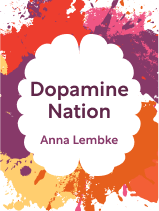

This article is an excerpt from the Shortform book guide to "Dopamine Nation" by Anna Lembke. Shortform has the world's best summaries and analyses of books you should be reading.
Like this article? Sign up for a free trial here.
What is delayed gratification? What are some ways to practice delaying gratification? Why does your brain thrive on instant gratification?
Author Anna Lembke discusses practicing delayed gratification in her self-help book, Dopamine Nation. According to her, overindulgence is fueled by the pursuit of instant gratification, and learning how to delay gratification leads to a happier and more satisfying life.
Keep reading to learn Lembke’s ways to practice delayed gratification by pursuing long-term rewards.
Lembke on Practicing Delayed Gratification
According to Stanford University psychiatrist and addiction treatment expert Anna Lembke, overindulgence is driven by both neurochemical and emotional factors. Lembke claims that practicing delayed gratification is vital for improving your satisfaction in life, however, there are some obstacles to breaking out of the overindulgence cycle.
One obstacle Lembke identifies is the difficulty of choosing long-term rewards over short-term ones. Most people prefer the short-term rewards of indulgence because they are easier to obtain and they provide instant gratification—only feeling bad in the long run. On the other hand, practicing delayed gratification and going through withdrawal feels terrible in the short run, and only feels good after about two to four weeks.
Lembke goes on to clarify why we’re primed to ignore positive long-term effects for short-term gains. She explains that the pursuit of long-term and short-term rewards is handled by separate parts of the brain. Pursuing short-term rewards relies on emotional parts of the brain such as the amygdala. Pursuing long-term rewards requires effort by the prefrontal cortex, the part of the brain involved in logic, conceptual thinking, and long-term planning. In other words, you can chase what is in front of you by acting on emotional impulse, but practicing delayed gratification requires thinking logically about your goals.
While practicing delayed gratification may be hard for most people, those who compulsively overindulge are placed at a particular disadvantage because overindulging rewires their brains over time. Researchers have found that people who compulsively overindulge have lower-than-average connectivity between the reward pathways and the prefrontal cortex.
(Shortform note: Reward pathways are the channels your motivational chemicals, such as dopamine, take through your brain toward the various goals your brain sets for them. This means that the prefrontal cortex is less likely to interject with a logical argument when you pursue a short-term reward at the expense of a long-term one.)
Why Is Practicing Delayed Gratification So Hard?
In Predictably Irrational, Dan Ariely explains why prioritizing long-term rewards over short-term ones is a struggle for most people. He draws a distinction between “cool-state decisions” and “warm-state decisions.” You’re in a cool state when you feel calm and collected and in a warm state while experiencing intense emotions. It’s relatively easy to practice delayed gratification and make rational decisions when you’re in a cool state. However, when you’re in a warm state—such as when your brain is flooded with dopamine—it’s difficult to ignore your emotions or act rationally. He writes that most people are very poor at predicting how they will react in a warm state—they expect they’ll be able to stick to their cool-state decisions even when emotionally aroused.
He suggests that the solution to overcoming this gap isn’t a pledge to make better decisions but to prevent yourself from having to make decisions in a warm state at all. For example, Lembke’s suggestion to create physical distance from your desired indulgence helps to make the decision not to indulge for you.
| How Does Your Behavior Change Your Brain? Lembke’s discussion of connectivity between the prefrontal cortex and the brain’s reward pathways is related to the science of neuroplasticity. Neuroplasticity is your brain’s capacity to create new connections, learn, and change itself. Neuroscientists have learned this process happens continually based on how you use your brain. Your neurons grow and form connections in the areas of your brain you use the most, while they shrink and lose connections in the parts of your brain you use the least. For example, a musical instrument becomes easier to play the more you practice. But stop practicing for long enough and it becomes hard again. This is because the act of practicing uses your neurons involved in playing music, and they grow and shrink in response. How does this relate to practicing delayed gratification? If you always pursue the short-term emotional reward right in front of you, it strengthens the connection between the emotional parts of your brain and the reward pathways. Meanwhile, because you aren’t using your prefrontal cortex to think about long-term goals, the lack of activity causes those neurons to shrink and become disconnected from the reward pathways. Therefore you’re less likely to pursue long-term goals because your brain hasn’t built up a strong connection between prefrontal cortex and reward pathway required to do so. |
Dopamine and Instant Gratification
Contrary to popular misconception, dopamine isn’t the “happy chemical” that releases when you receive something pleasurable—it’s the chemical that motivates you to seek out pleasure. Studies have shown this chemical is largely responsible for pursuing instant gratification activities because it drives you to continually seek out pleasure while avoiding pain.
Practicing delayed gratification means abstaining from “high-dopamine activities”—some of the highest dopamine-driven activities include gambling, shopping, sex, and using cocaine or methamphetamines. However, Lembke points out that high-dopamine activities are not the same for everyone—the high-dopamine activity that motivates you to indulge compulsively may be something “milder” like sugar, video games, or social media.
| Practicing Delayed Gratification: The Challenge of Addictive Activities Understanding that dopamine is the chemical that drives us to seek out instant gratification sheds light on how many of the activities people engage with every day are designed to manipulate their brains and keep them in a state of overindulgence. Game designers in particular have realized that your brain releases dopamine when you feel you are close to obtaining a reward. Therefore, they’ve developed proven strategies to make you feel close to winning—and therefore engaged in—their games. Let’s explore three of the most common tactics: 1. Dangling a large unobtainable reward. If you are constantly reminded that you have a chance to hit the jackpot, you will remain in a state of dopamine arousal. For example, carnival games often display one big prize, like a giant stuffed animal, that’s almost impossible to win. 2. The “near miss” effect. Players are likely to experience a rush of dopamine if they feel they almost got a reward, and might get it on their next try. For example, a slot machine requiring you to match three characters will create a “near miss” effect if you match two of them, making it feel like you were closer to winning than you really were. 3. Unpredictable rewards. Studies have found games that reward players unpredictably are more addictive than games with predictable rewards. Unpredictable rewards mean that there’s always a possibility that you could win big on the next play. Gambling is the most obvious example, but consider that popular video games like World of Warcraft use this too. If monsters drop loot randomly, then the next monster you defeat could always be the one that drops a rare item. |

———End of Preview———
Like what you just read? Read the rest of the world's best book summary and analysis of Anna Lembke's "Dopamine Nation" at Shortform.
Here's what you'll find in our full Dopamine Nation summary:
- What causes addictive behaviors and how to take back control
- How pleasure and pain motivate you to consume
- Strategies for keeping your brain’s natural chemicals in balance






